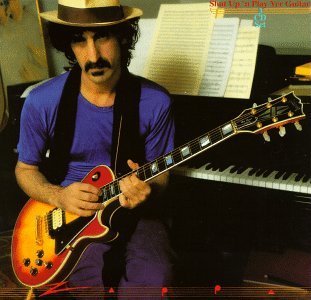Top Qs
Timeline
Chat
Perspective
Shut Up 'n Play Yer Guitar
1981 triple album by Frank Zappa From Wikipedia, the free encyclopedia
Remove ads
Shut Up 'n Play Yer Guitar is a series of three albums - Shut Up 'n Play Yer Guitar, Shut Up 'n Play Yer Guitar Some More, and Return of the Son of Shut Up 'n Play Yer Guitar - released by American musician Frank Zappa in 1981. The albums consist solely of electric guitar instrumentals and improvised solos (mostly) played live by Zappa and featuring a wide variety of backing musicians.
The music was well received by critics, and Zappa subsequently produced additional albums focusing solely on guitar-oriented instrumental music.
The albums were initially released as individual LPs in May 1981 on Barking Pumpkin Records and sold only through mail order in the United States. The recordings were subsequently reissued as a triple album box set in 1982 and distributed by CBS Records in Europe. The complete package later appeared as a two CD set.
Remove ads
Background
After the release of Joe's Garage, Frank Zappa set up his home studio, the Utility Muffin Research Kitchen, and planned to release a triple LP live album called Warts and All. As this project neared completion, Zappa found it to be "unwieldy" due to its length.[1][2] Zappa later conceived the Shut Up 'N Play Yer Guitar series, which contained two tracks originally prepared for Warts and All.[2]
Content
The music is entirely instrumental but interspersed with brief bits of comic dialogue from Zappa band members. More of these bits appear on other Zappa albums such as Läther.
Most solos come from live performances. The three title tracks are all derived from the song "Inca Roads"; various other solos were taken from "Conehead", "Easy Meat", "The Illinois Enema Bandit", "City of Tiny Lites", "Black Napkins", "The Torture Never Stops", "Chunga's Revenge", and "A Pound for a Brown on the Bus". "Ship Ahoy" was the coda from a performance of "Zoot Allures" the first part of which appears on You Can't Do That on Stage Anymore, Vol. 3.
The final track, "Canard du Jour", is a duet with Frank Zappa on electric bouzouki and Jean-Luc Ponty on baritone violin dating from a 1972 studio session.
Some of the solos from these albums are featured in written form in The Frank Zappa Guitar Book.
Remove ads
Reception
Reviewing the album's double CD incarnation in a retrospective assessment for AllMusic, Sean Westergaard wrote, "Frank Zappa [...] was one of the finest and most under appreciated guitarists around. [...] This is an album that should be heard by anyone who's into guitar playing."[3] Another writer for the website, Lindsay Planer, similarly appraised the individual releases Shut Up 'n Play Yer Guitar Some More and Return of the Son of Shut Up 'n Play Yer Guitar, writing of Some More, "it is certainly a wonderful place for interested parties to commence their discovery of the (dare say) many moods Zappa imbued in carefully constructed yet thoroughly improvised compositions such as the seven found here."[4] In regard to Return of the Son, Planer wrote that Zappa "saved some of his best offerings [...] Zappa pours his expansive ideas onto the soundscape with a certainty and purpose that is simply unmatched in terms of passion and inspiration."[5]
Legacy
In 1988 Zappa released Guitar, intended as a successor/companion to Shut Up 'n Play Yer Guitar. He also assembled a further album of live guitar solos, Trance-Fusion, shortly before his death in 1992. This album was released posthumously in 2006. Additionally, Zappa assembled the compilation The Guitar World According to Frank Zappa for Guitar World magazine in 1987. In 1997, Dweezil Zappa assembled another compilation of Zappa's guitar-based songs and solos, Frank Zappa Plays the Music of Frank Zappa: A Memorial Tribute.
Remove ads
Track listing
Summarize
Perspective
All tracks written by Frank Zappa except "Canard du Jour" which was improvised by Zappa and Jean-Luc Ponty

Shut Up 'n Play Yer Guitar

Shut Up 'n Play Yer Guitar Some More

Return of the Son of Shut Up 'n Play Yer Guitar
Remove ads
Personnel
- Frank Zappa – Lead Guitar (all tracks except 20), Bouzouki (track 20)
- Denny Walley – Rhythm Guitar (tracks 1, 3, 5, 9, 12, 13, 16, 18)
- Ray White – Rhythm Guitar (tracks 2, 6–8, 14, 15, 17)
- Ike Willis – Rhythm Guitar (tracks 1–3, 5–9, 12, 13, 15–19)
- Steve Vai – Rhythm Guitar (tracks 2, 6–8, 15, 17)
- Warren Cuccurullo – Rhythm Guitar (tracks 1, 3, 4, 9, 12, 13, 16, 18, 19), Electric Sitar (tracks 5, 10)
- Jean-Luc Ponty – Baritone Violin (track 20)
- Tommy Mars – keyboards (tracks 1–3, 5–9, 12, 13, 15–18)
- Bob Harris – keyboards (tracks 2, 6–8, 15, 16)
- Peter Wolf – keyboards (tracks 1, 3, 5, 9, 12, 13, 16, 18)
- Andre Lewis – keyboards (track 11)
- Eddie Jobson – keyboards (track 14)
- Patrick O'Hearn – bass (tracks 10, 14,), Dialogue
- Arthur Barrow – bass (tracks 1–3, 5–9, 12, 13, 15–18)
- Roy Estrada – bass (track 11)
- Vinnie Colaiuta – drums (all tracks except 11, 14, 20)
- Terry Bozzio – drums (tracks 11, 14), dialogue
- Ed Mann – percussion (tracks 1, 3, 5, 9, 12, 13, 16, 18)
Remove ads
Production
- Frank Zappa – arranger, composer, Conductor, Producer
- Kerry McNabb – engineer
- Steve Nye – engineer
- Jo Hansch – Mastering
- John Swenson – Liner Notes
- John Livzey – Photography
- John Vince – Graphic Design
- Bob Stone – remixing
- Joe Chiccarelli – engineer, mixing (Berkley Theatre)
- George Douglas – Live Recording Engineer, UMRK Mobile
- Tom Flye – engineer
- Mick Glossop – engineer
References
Wikiwand - on
Seamless Wikipedia browsing. On steroids.
Remove ads

